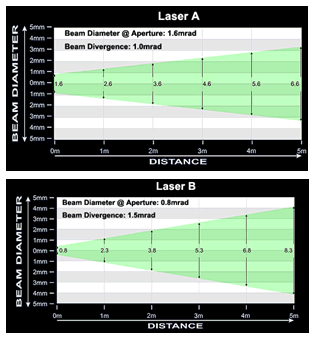 Beam Divergence
Beam Divergence Beam diameter and beam divergence are two of the most important technical specifications to consider when choosing a laser. Obviously beam diameter is just the diameter of a laser beam, measured in millimeters. Beam divergence measures how much the laser beam expands per meter. For example, a laser with a beam divergence of 1.0mRad will have a beam that expands 1.0mm per meter. It all comes down to how small the end "spot" (the diameter size of your laser beam) is at certain distances. Common senses tell us that if a laser beam diameter is small, it can go further and burn with more power than if it is big. Ideally, we want to have small beam diameter at aperture AND small beam divergence. you can't have both a small beam diameter and a small beam divergence. According to the Laws of Photonics, these two specifications have an inverse relationship; if one increases, the other must decrease.
Beam diameter and beam divergence are two of the most important technical specifications to consider when choosing a laser. Obviously beam diameter is just the diameter of a laser beam, measured in millimeters. Beam divergence measures how much the laser beam expands per meter. For example, a laser with a beam divergence of 1.0mRad will have a beam that expands 1.0mm per meter. It all comes down to how small the end "spot" (the diameter size of your laser beam) is at certain distances. Common senses tell us that if a laser beam diameter is small, it can go further and burn with more power than if it is big. Ideally, we want to have small beam diameter at aperture AND small beam divergence. you can't have both a small beam diameter and a small beam divergence. According to the Laws of Photonics, these two specifications have an inverse relationship; if one increases, the other must decrease.
A detailed example should help clear everything up. Let's say we have two lasers. One laser (Laser A) has a beam diameter of 1.6mm at aperture and a beam divergence of 1.0mRad. The specs for the other laser (Laser B) are 0.8mm and 1.5mRad respectively. At aperture, the diameter of the Laser B is only one half that of the Laser A. At equal power output, the Laser B actually has four times more burning power than the Laser A (burning power is proportional to area, which is proportional to the square of the diameter)! However, at a distance of two meters, the beam diameter of the Laser A and the Laser B are nearly identical; the burning capabilities are also nearly identical. At five meters, the Laser A actually has the smaller beam diameter. The conclusion here is that the Laser with small beam divergence is better for long distance pointing as its beam will grow slower with distance.